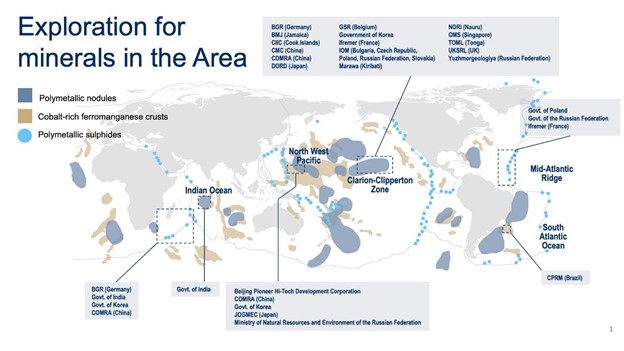Table of Contents
Context: A study published in Nature Geoscience has ignited a debate among scientists about the potential production of oxygen in the deep sea without the need for sunlight.
What is Dark Oxygen?
- “Dark oxygen” refers to oxygen found in deep ocean regions where photosynthesis cannot occur due to the absence of sunlight.
- In such areas, known as the abyssal zone, oxygen levels are typically low and rely on global ocean circulation for replenishment.
- It refers to the production of molecular oxygen (O₂) in the deep ocean, specifically at depths where sunlight cannot penetrate, (thus making photosynthesis impossible).
- We usually believe that oxygen on Earth comes from photosynthesis—a process where plants, algae, and bacteria use sunlight to turn carbon dioxide into oxygen.
- Scientists studying polymetallic nodules—potato-sized metal-rich rocks found in deep-sea regions—suggested they could be producing electrical current.
- This electrical current could potentially split seawater into hydrogen and oxygen via electrolysis, leading to the formation of “dark oxygen.”
- The findings challenge the widely accepted belief that oxygen first emerged on Earth around 2.7 billion years ago through photosynthesis, which requires sunlight.
- The research was conducted in the Clarion-Clipperton Zone, an underwater area between Mexico and Hawaii, known for its rich mineral deposits and growing interest in deep-sea mining.
| More in News |
|
What is Deep Sea Mining?
- Deep-sea mining is the process of retrieving mineral deposits from the deep seabed – the ocean below 200m.
- The deep seabed is the seabed at ocean depths greater than 200m, and covers about two-thirds of the total seafloor.
- The deep sea is full of biodiversity, rich in living resources used in medicines and critical in regulating the climate and providing spawning and feeding grounds for fish.
- Seabed mining is done through a huge vacuum that simply travels over the ocean floor to suck up the nodules which are then brought to the surface with a hose.

Why Move Towards Deep Sea Mining?
- Critical Minerals: The deep sea contains three primary sources for mining critical minerals:
- Potato-size manganese nodules (rich in manganese, cobalt, copper, nickel, and rare earth elements);
- Deposits of sulphur-containing minerals around underwater openings known as hydrothermal vents; and
- Cobalt-rich crusts lining the sides of mid-ocean ridges and underwater mountains, also known as seamounts.
- Facilitate Energy Transition: Copper or nickel for batteries, cobalt for electric cars or manganese for steel production: rare earth minerals and metals are fundamental to the renewable energy technologies driving the world’s energy transition.
- These are key to making modern gadgets, from smartphones and laptops to pacemakers, hybrid cars and solar panels. Carmakers will need more of these metals in order to make battery cathodes and electrical connectors for an electric vehicle fleet.

- Depleting Terrestrial Deposits: Expanding technology and infrastructure has fueled the global demand for resources like cobalt and nickel, whose supply is depleting fast onshore. Hence, more and more countries, including manufacturing powerhouses India and China, are moving towards the ocean for extracting these resources.
- Potential Zones: The Clarion-Clipperton Zone between Hawaii and Mexico is a potential hotbed for critical minerals. The basin in the central Indian Ocean and the seabed off the Cook Islands, Kiribati atolls and French Polynesia in the South Pacific are also of interest for potential extraction.
Impact of Deep-Sea Mining
Ecological Concerns
- The discovery of “dark oxygen” underscores the potential ecological risks associated with deep-sea mining. The unique marine ecosystems that rely on this oxygen could be disrupted, leading to significant and possibly irreversible environmental impacts.
- Historical evidence, such as the DISCOL Experiment, has demonstrated long-term ecological damage from simulated mining activities, including reduced biodiversity and altered sedimentological profiles.
Industry Response and Challenges
- In response to growing concerns, major European insurance companies have announced they would exclude deep-sea mining from their underwriting portfolios.
- The discovery of “dark oxygen” adds complexity to the debate on deep-sea mining. Without sustainable practices, such mining could become unfeasible due to its potential negative impacts on marine ecosystems.
Way Forward
Develop Comprehensive Environmental Regulations
- Governments should establish and enforce robust environmental regulations and impact assessment protocols for deep-sea mining to ensure that the industry operates sustainably.
Promote Sustainable Mining Practices
- There is a need to invest in research and innovation to develop and implement technologies and methods that minimize the environmental impact of deep-sea mining.
- Collaborating with scientific communities to better understand deep-sea ecosystems and the effects of mining on these environments is crucial for developing sustainable practices.
Conclusion
The discovery of “dark oxygen” has added a new layer of complexity to the already contentious issue of deep-sea mining. As the world increasingly turns to the ocean for valuable resources, it is imperative to balance economic interests with environmental stewardship. The path forward must prioritize sustainability to protect the unique and largely unexplored ecosystems of the deep sea, ensuring that future generations inherit a healthy and thriving ocean.


 Vitamin D Deficiency: Causes, Symptoms a...
Vitamin D Deficiency: Causes, Symptoms a...
 GAURAV: Long Range Glide Bomb (LRGB)
GAURAV: Long Range Glide Bomb (LRGB)
 Gestational Diabetes Mellitus (GDM), Cau...
Gestational Diabetes Mellitus (GDM), Cau...





















